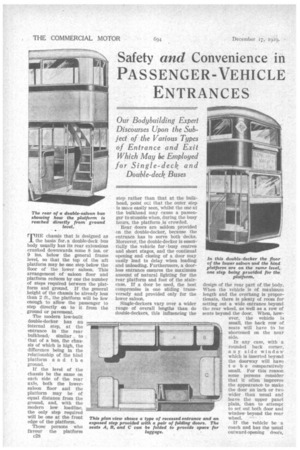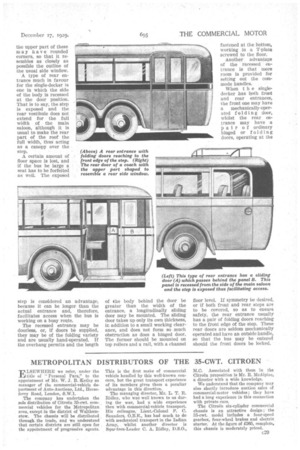Safety and Convenience in
Page 50

Page 51

If you've noticed an error in this article please click here to report it so we can fix it.
PASSENGER-VEHICLE ENTRANCES
Our Bodybuilding Expert Discourses Upon the Subject of the Various Types of Entrance and Exit Which May be Employed for Single-deck and Double-deck Buses
THE chassis that is designed as the basis for. a double-deck bus body usually has its rear extensions
cranked downwards some 8 ins. or 9 ins, below the general frame level, so that the top of the aft platform rnay be one step below the floor of the lower saloon. This arrangement of saloon floor and platform reduces by one the number of steps required between the plat form and ground. If the general
height of the chassis be already less than 2 ft.,-the platform will be low
enough to allow the passenger to step directly on to it from the ground or pavement.
The modern low-built double-decker has an internal step, at the entrance in the rear bulkhead,similar to that of a bus, the chassis of which is high, the difference being in the relationship of the hind platform and the ground.
If the level of the chassis be the same on each side of the rear axle, both the lowersaloon floor and the platform may be of equal distance from the ground, and, with the modern low loadline, the only step required will be one at the front edge of the platform.
Those persons who favour the platform c28 step rather than that at the bulkhead, point out that the outer step is moce easily seen, whilst the one at the bulkhead may cause a passenger to stumble when, during the busy hours, the platform is' crowded.
Rear doors are seldom provided on the double-decker, because the entrance has to serve both decks. Moreover, the double-decker is essentially the vehicle for -busy centres and short stages, and the continual opening and closing of a door may easily lead to delay when loading and unloading. Furthermore, a doorless entrance ensures the maximum amount of natural lighting for the rear platform and foot of the staircase. If a door be used, the best compromise is one sliding transversely and provided only for the lower saloon.
Single-deckers vary over a wider range of overall lengths than do double-deckers, this influencing the design of the rear part of the body. When the vehicle is of maximum length and the overhang is proportionate, there is plenty of room for setting out a wide entrance beyond the rear wheel, as well as a row of seats beyond the door. When, however, the vehicle is small, the back row of seats will have to be shortened on the near side.
In any case, with a rounded back corner, any side window which is inserted beyond the doorway will have to be comparatively small. For this reason some persons consider that it often improves the appearance to make the door an inch or two wider than usual and leave the upper panel plain, than to attempt to set out both door and window beyond the rear wheel. , If the vehicle be a coach and has the usual outward-opening door's, the upper part of these may have rounded corners, so that it resembles as closely as possible the outline of the usual side window.
A type of rear entrance much In favour for the single-decker is one in which the side of the body is recessed at the door position. That is to say, the step is exposed and the rear vestibule does not extend for the full width of the main saloon, although it is usual to make the rear part of the roof the full width, thus acting as a canopy over the step.
A certain amount of floor space is lost, and if the bus be large a seat has to be forfeited as well. The exposed step is considered an advantage, because it can be longer than the actual entrance and, therefore, facilitates access when the bus is working on a busy route.
The recessed entrance may be doorless, or, if doors be supplied, they may be of the folding variety and are usually hand-operated. If the overhang permits and the length of the body behind the door be greater than the width of the entrance, a longitudinally sliding door may be mounted. The sliding door takes up only its own thickness, in addition to a small working clearance, and does not form so much obstruction as does a hinged door. The former should be mounted on top rollers and a rail, with a channel fastened at the bottom, working in a T-plate screwed to the floor.
Another advantage of the recessed entrance is that more room is provided for setting out the commode handles.
When t 11 e singledecker has both front and rear entrances, the front one may have a mechanically-operated folding door, whilst the rear entrance may have a pair of ordinary hinged or folding doors, operating at the floor level. If symmetry be desired, or if both front and rear steps are to be covered, so as to ensure safety, the rear entrance usually has a--pair of folding doors reaching to the front edge of the step. These rear doors are seldom mechanically operated and have an outside handle, so that the bus may be entered should the front doors be locked.












































































































